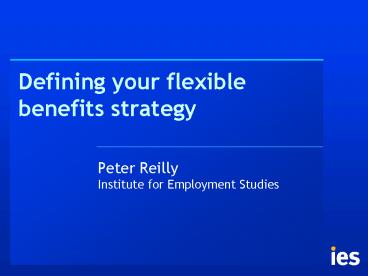Defining your flexible benefits strategy - PowerPoint PPT Presentation
1 / 24
Title:
Defining your flexible benefits strategy
Description:
Holidays. Sick pay. Training/career development. On site car parking. Drinks ... definition of total reward. WorldatWork's total reward & employee engagement model ... – PowerPoint PPT presentation
Number of Views:94
Avg rating:3.0/5.0
Title: Defining your flexible benefits strategy
1
Defining your flexible benefits strategy
- Peter ReillyInstitute for Employment Studies
2
Todays agenda
- Why flex is of interest to organisations
- The pros and cons of going for flex
- Ensuring flex is right for your organisation
- How to present your business case to the
board/financial director - The place of flex in your total reward approach
3
Drivers towards flex
- Individualised and consumer society
- Demand for choice
- Diverse workforce various needs to satisfy
- Legal pressures to move away from service and
age related benefits - Managing costs in tenure related benefits and
through tax optimisation - Something new to offer in tight labour market
4
A word of caution!
- According to CIPDs reward survey
- Only 8 of organisations offer flex benefits(but
29 of organisations with 5,000 staff) - Yet it costs 15 of payroll
- Top ten benefits include
- Holidays
- Sick pay
- Training/career development
- On site car parking
- Drinks
- Xmas party
- Life assurance
- Healthcare
- Car allowance
- Childcare vouchers
5
The flexible benefits case
- Concerns
- Set up expense
- Administrative time and effort
- Hidden costs in pattern of choice
- Poor valuation of benefits or estimation
oftake-up
- Plus points
- Employer of choice/attractive brand
- Responsive to diverse workforce
- More engaged workforce
- higher retention
- better attendance
- greater satisfaction with reward
6
The flexible benefits case, cont.
- Concerns
- Frustration if there is little choice/ poor
scheme design - Abuse of benefits (eg flexitime)
- Not enough reward to justify statements
- Plus points
- Avoiding age (status?) based entitlements
- Ability to harmonise different TCs
- Capping costs,passed to employee
- Improved staff understanding of reward range/costs
7
The flexible benefits case, cont.
- Concerns
- Unexpected tax bill
- Union (employee?) resistance if seen as at
expense of base pay - Misalignment between benefits offered and brand
- Eligibility rules can frustrate
- Plus points
- Avoiding NI/tax,for employee employer
- Using corporate buying power
- Offering own products or services
- Pay can easily be matched (bettered)
- Unmemorable bonuses
8
What do people spend cash rewards on?
Source Maritz
9
Drivers for benefits in the US
10
Benefits developments in UK
ChildcareBikes Dental Health Paternity Leave
Childcare Vouchers Leave Cars Car allowance
Source CIPD Reward Survey 2008
11
Determining whether flex is right for you?
- Understand the employee profile
- Discover what they want(and future potential
recruits)
12
Understanding employee needs in US organisations
13
Determining whether flex is right for you?
- Understand the employee profile
- Discover what they want(and future potential
recruits) - Recognise importance of perceived value
- Estimate the diversity of aspirations
- Be realistic about funding
- and with the benefits you can offer
- Question your technology capability
- and your administrative resources
14
Building the business case
- How do you flex plans connect with your business
strategy and HR policies? - Is your aim to
- be an employer of choice or to cut costs?
- achieve cultural fit or cultural change?
- contribute to total reward or stand alone?
- send value signals (eg CSR/green agenda)
- segment your offer through targeting
- Can you produce evidence on the business benefits
of flex (outweighing the cost) - and that you have done a proper risk analysis
15
Cost v benefit curve
benefit
cost
Time
16
Fit with the business strategy
17
Fit with the business strategy
- paybill control
- simple pay systems
- output perf driven
18
and integration HR policies and practices
business strategy
19
Total reward
- A philosophy, a set of principles, a mindset,
rather than a set of particular reward
practices. - Schuster and Zingheim
20
Components of total reward
Compelling future Vision/values Growth/success Pos
itive brand
Positive workplace People focus Leadership Collegi
ality Trust/recognition Involvement/openness
Individual growth Development/training Career
enhancement
Total remuneration Base Variable Benefits
Adapted from Schuster and Zingheim, 2000
21
Michael Armstrongs definition of total reward
Total reward includes all types of reward ?
non-financial as well as financial, indirect as
well as direct, extrinsic as well as intrinsic.
It is a value proposition which embraces
everything that people value in the employment
relationship and is developed and implemented as
an integrated and coherent whole.
22
WorldatWorks total reward employee engagement
model
23
WorldAtWork knowledge of pay model
24
thank you
www.employment-studies.co.uk

